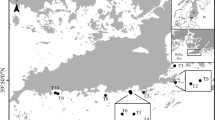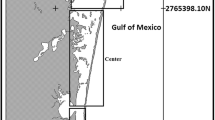Abstract
Human disturbances, such as anchoring and dredging, can cause physical removal of seagrass rhizomes and shoots, leading to the fragmentation of meadows. The introduced green alga, Caulerpa racemosa, is widely spread in the North-West Mediterranean and, although it can establish in both degraded and pristine environments, its ability to become a dominant component of macroalgal assemblages seems greater in the former. The aim of this study was to estimate whether the spread of C. racemosa depends on the intensity of disturbance to the canopy structure of Posidonia oceanica. A field experiment was started in July 2010 when habitat complexity of a P. oceanica meadow was manipulated to simulate mechanical disturbances of different intensity: rhizome damage (High disturbance intensity = H), leaf removal (Low disturbance intensity = L), and undisturbed (Control = C). Disturbance was applied within plots of different size (40 × 40 cm and 80 × 80 cm), both inside and at the edge of the P. oceanica meadow, according to an orthogonal multifactorial design. In November 2011 (16 months after the start of the experiment), no C. racemosa was found inside the seagrass meadow, while, at the edge, the cover of the seaweed was dependent on disturbance intensity, being greater where the rhizomes had been damaged (H) than in leaf removal (L) or undisturbed (C) plots. The results of this study indicate that physical disturbance at the margin of seagrass meadows can promote the spread of C. racemosa.



Similar content being viewed by others
References
Airoldi L (1998) Roles of disturbance, sediment stress, and substratum retention on spatial dominance in algal turf. Ecology 79:2759–2770
Ardizzone G, Belluscio A, Maiorano L (2006) Long-term change in the structure of a Posidonia oceanica landscape and its reference for a monitoring plan. Mar Ecol 27:299–309
Boudouresque CF (2003) The erosion of Mediterranean biodiversity. In: Rodriguez-Prieto C, Pardini G (eds) The Mediterranean sea: an overview of its present state and plans for future protection. Servei de Publicacions de la Universitat de Girona, Girona, pp 53–112
Boudouresque CF, Ballesteros E, Ben Maiz N, Boisset F, Bouladier E, Cinelli F, Cirik S, Cormaci M, Jeudy De Grissac A, Laborel J, Lanfranco E, Lundberg B, Mayhoub H, Meisnez A, Panayotidis P, Semroud R, Sinnassamy JM, Span A, Vuignier G (1990) Livre rouge “Gérard Vuigner” des végétaux, peuplements et paysages marins menaces de Méditerranée. PNUE Publications, Athens 250
Boudouresque CF, Bernard G, Pergent G, Shili A, Verlaque M (2009) Regression of Mediterranean seagrasses caused by natural processes and anthropogenic disturbances and stress: a critical review. Bot Mar 52(5):395–418
Bruno JF, Stachowicz JJ, Bertness MD (2003) Inclusion of facilitation into ecological theory. Trends Ecol Evol 18:19–125
Bulleri F, Balata D, Bertocci I, Tamburello L, Benedetti-Cecchi L (2010) The seaweed Caulerpa racemosa on Mediterranean rocky reefs: from passenger to driver of ecological change. Ecology 91:2205–2212
Bulleri F, Alestra T, Ceccherelli G, Tamburello L, Pinna S, Sechi N, Benedetti-Cecchi L (2011) Determinants of Caulerpa racemosa distribution in the north-western Mediterranean. Mar Ecol Prog Ser 431:55–67
Byers JE (2002) Physical habitat attribute mediates biotic resistance to non-indigenous species invasion. Oecologia 130:146–156
Ceccherelli G, Piazzi L (2001) Dispersal of Caulerpa racemosa fragments in the Mediterranean: lack of detachment time effect on establishment. Bot Mar 44:209–213
Ceccherelli G, Piazzi L, Cinelli F (2000) Response of the non-indigenous Caulerpa racemosa (Forsskal) J-Agardh to the native seagrass Posidonia oceanica (L.) Delile: effect of density of shoots and orientation of edges of meadows. J Exp Mar Biol Ecol 243:227–240
Ceccherelli G, Piazzi L, Balata D (2002) Spread of introduced Caulerpa species in macroalgal habitats. J Exp Mar Biol Ecol 280:1–11
Ceccherelli G, Campo D, Milazzo M (2007) Short-term response of the slow growing seagrass Posidonia oceanica to simulated anchor impact. Mar Environ Res 63:341–349
Clark GF, Johnston EL (2011) Temporal change in the diversity–invasibility relationship in the presence of a disturbance regime. Ecol Lett 14:52–57
D’Antonio CM, Vitousek PM (1992) Biological invasions by exotic grasses, the grass: fire cycle, and global change. Ann Rev Ecol Evol S 23:63–87
Davis MA, Grime JP, Thompson K (2000) Fluctuating resources in plant communities: a general theory of invasibility. J Ecol 88:524–534
Dayton PK (1975) Experimental evaluation of ecological dominance in a rocky intertidal community. Ecol Monogr 45:137–159
Dethier MN, Graham ES, Cohen S, Tear LM (1993) Visual versus random-point percent cover estimations: ‘objective’ is not always better. Mar Ecol Progr Ser 110:9–18
Dietz H, Edwards PJ (2006) Recognition that causal processes change during plant invasion helps explain conflicts in evidence. Ecology 87:1359–1367
Driscoll DA (2007) How to find a metapopulation. Can J Zool 85:1031–1048
Dumay O, Pergent G, Pergent-Martini C, Amade P (2002) Variations in caulerpenyne contents in Caulerpa taxifolia and Caulerpa racemosa. J Chem Ecol 28(2):343–352
Francour P, Ganteaume A, Poulain M (1999) Effect of boat anchoring in Posidonia oceanica seagrass beds in the Port-Cros national park (north-western Mediterranean sea). Aquat Conserv 9:391–400
Glasby TM (2013) Caulerpa taxifolia in seagrass meadows: killer or opportunistic weed? Biol Invas 15:1017–1035
Hemminga MA, Duarte CM (2000) Seagrass ecology. Cambridge University Press, Cambridge
Hobbs RT, Huenneke LF (1992) Disturbance, diversity, and invasion: implications for conservation. Conserv Biol 6:324–337
Irving AD, Connell SD (2006) Predicting understorey structure from the presence and composition of canopies: an assembly rule for marine algae. Oecologia 148:491–502
Johnston EL, Keough MJ (2002) Direct and indirect effects of repeated pollution events on marine hard-substrate assemblages. Ecol Appl 12:1212–1228
Katsanevakis S, Issaris Y, Poursanidis D, Thessalou-Legaki M (2010) Vulnerability of marine habitats to the invasive green alga Caulerpa racemosa var. cylindracea within a marine protected area. Mar Env Res 70:210–218
Kiparissis S, Fakiris E, Papatheodorou G, Geraga M, Kornaros M, Kapareliotis A, Ferentinos G (2011) Illegal trawling and induced invasive algal spread as collaborative factors in a Posidonia oceanica meadow degradation. Biol Invas 13:669–678
Klein J, Verlaque M (2008) The Caulerpa racemosa invasion: a critical review. Mar Poll Bull 56:645–650
Lohrer AM, Chiaroni LD, Hewitt JE, Thrush SF (2008) Biogenic disturbance determines invasion success in a subtidal soft-sediment system. Ecology 89:1299–1307
Mack RN, Simberloff D, Lonsdale WM, Evans H, Clout M et al (2000) Biotic invasions: causes, epidemiology, global consequences, and control. Ecol Appl 10:689–710
Milazzo M, Badalamenti F, Ceccherelli G, Chemello R (2004) Boat anchoring on Posidonia oceanica beds in a marine protected area (Italy, western Mediterranean): effect of anchor types in different anchoring stages. J Exp Mar Biol Ecol 299:51–62
Montefalcone M, Morri C, Peirano A, Albertelli G, Bianchi CN (2007) Substitution and phase shift within the Posidonia oceanica seagrass meadows of NW Mediterranean Sea. Estuar Coast Shelf Sci 75:63–71
Montefalcone M, Chiantore M, Lanzone A, Morri C, Albertelli G, Bianchi CN (2008) BACI design reveals the decline of the seagrass Posidonia oceanica induced by anchoring. Mar Poll Bull 56(9):1637–1645
Montefalcone M, Albertelli G, Morri C, Bianchi CN (2010) Patterns of wide-scale substitution within meadows of the seagrass Posidonia oceanica in NW Mediterranean Sea: invaders are stronger than natives. Aquat Conserv 20(5):507–515
Paine RT (2002) Trophic control of production in a rocky intertidal community. Science 296:736–739
Pearson SM (1993) The spatial extent and relative influence of landscape-level factors on wintering bird populations. Landsc Ecol 8:3–18
Peirano A, Bianchi CN (1997) Decline of the seagrass Posidonia oceanica in response to environmental disturbance: a simulation-like approach off Liguria (NW Mediterranean Sea). In: Hawkins LE, Hutchinson S (eds) The response of Marine organisms to their environments. University of Southampton, UK, pp 87–95
Pérès JM (1984) La regression des herbiers à Posidonia oceanica. In: Boudouresque CF, Jeudy De Grissac A, Olivier J (eds) First international workshop on Posidonia oceanica beds. GIS Posidonie Publ, France, pp 445–454
Pergent G (1992) Key species in the Mediterranean littoral. The importance of Posidonia oceanica meadows. The European coastline study. European Science Foundation and Commission of the European Communities, Galway, pp 32–36
Pergent G, Pergent-Martini C, Boudouresque CF (1995) Utilisation de l’herbier à Posidonia oceanica comme indicateur biologique de la qualité du milieu littoral en Méditerranée: Etat des connaissances. Mésogée 54:3–29
Piazzi L, Balata D (2009) Invasion of alien macroalgae in different Mediterranean habitats. Biol Inv 11:193–204
Piazzi L, Cinelli F (1999) Development and seasonal dynamics of a population of the tropical alga Caulerparacemosa (Forsskål) J Agardh in the Mediterranean. Cryptogam Algol 20:295–300
Piazzi L, Ceccherelli G, Cinelli F (2001) Threat to macroalgal diversity: effects of the introduced green alga Caulerpa racemosa in the Mediterranean. Mar Ecol Progr Ser 210:149–159
Piazzi L, Ceccherelli G, Balata D, Cinelli F (2003) Early patterns of Caulerpa racemosa in the Mediterranean Sea: the influence of algal turfs. J Mar Biol Assoc UK 83:27–29
Piazzi L, Meinesz A, Verlaque M, Akçali B, Antolić B, Argyrou M, Balata D, Ballesteros E, Calvo S, Cinelli F, Cirik S, Cossu A, D’Archino R, Djellouli AS, Javel J, Lanfranco E, Mifsud C, Pala D, Panayotidis P, Peirano A, Pergent G, Petrocelli A, Ruitton S, Žuljević A, Ceccherelli G (2005) Invasion of Caulerpa racemosa var. cylindracea (Caulerpales, Chlorophyta) in the Mediterranean Sea: an assessment of the spread. Cryptogam Algol 26:189–202
Predick KI, Turner MG (2008) Landscape configuration and flood frequency influence invasive shrubs in floodplain forests of the Wisconsin River (USA). J Ecol 96:91–102
Richardson DM, Holmes TM, Esler KJ, Galatowitsch SM et al (2000) Riparian vegetation degradation, alien plant invasions, and restoration prospects. Divers Distrib 13:126–139
Ricketts TH (2001) The matrix matters: effective isolation in fragmented landscapes. Am Nat 158:87–99
Ruitton S, Javel F, Culioli JM, Meinesz A, Pergent G, Verlaque M (2005) First assessment of the Caulerpa racemosa (Caulerpales, Chlorophyta) invasion along the French Mediterranean coast. Mar Pollut Bull 50:1061–1068
Shea K, Chesson P (2002) Community ecology theory as a framework for biological invasions. Trends Ecol Evol 17:170–176
Tamburello L, Benedetti-Cecchi L, Ghedini G, Alestra T, Bulleri F (2012) Variation in the structure of subtidal landscapes in the NW Mediterranean Sea. Mar Ecol Progr Ser 457:29–41
Tamburello L, Bulleri F, Balata D, Benedetti-Cecchi L (2014) The role of overgrazing and anthropogenic disturbance in shaping spatial patterns of distribution of an invasive seaweed. J Appl Ecol. doi:10.1111/1365-2664.12199
Theoharides KA, Dukes JS (2007) Plant invasion across space and time: factors affecting nonindigenous species success during four stages of invasion. New Phytol 176:256–273
Thomas JA, Bourn NAD, Clarke RT, Stewart KE, Simcox DJ, Pearman GS, Curtis R, Goodger B (2001) The quality and isolation of habitat patches both determine where butterflies persist in fragmented landscapes. Proc R Soc Lond Ser B Biol Sci 268:1791–1796
Underwood AJ (1997) Experiments in ecology: their logical design and interpretation using analysis of variance. Cambridge University Press, Cambridge
Waycott M, Duarte CM, Carruthers TJB, Orth RJ, Dennison WC, Olyarnik S, Calladine A, Forqurean JW, Heck KL, Hughes AR, Kendrick GA, Kenworthy WJ, Short FT, Williams SL (2009) Accelerating loss of seagrasses across the globe threatens coastal ecosystems. P Natl Acad Sci USA 106(30):12377–12381
Wiens JA, Stenseth NC, Van Horne B, Ims RA (1993) Ecological mechanisms and landscape ecology. Oikos 66:369–380
Williams SL (2007) Introduced species in seagrass ecosystems: status and concerns. J Exp Mar Biol Ecol 350:89–110
Williams SL, Smith JE (2007) A global review of the distribution, taxonomy and impacts of introduced seaweeds. Annu Rev Ecol Syst 38:327–359
Acknowledgments
We sincerely thank Francesco Mura for help with fieldwork and boating operations. S.P. was supported by funds from a “Regione Autonoma della Sardegna” (PO Sardegna FSE 2007-2013 LR7/2007) Grant. Two anonymous reviewers provided comments and constructive criticism on earlier draft.
Author information
Authors and Affiliations
Corresponding author
Rights and permissions
About this article
Cite this article
Ceccherelli, G., Pinna, S., Cusseddu, V. et al. The role of disturbance in promoting the spread of the invasive seaweed Caulerpa racemosa in seagrass meadows. Biol Invasions 16, 2737–2745 (2014). https://doi.org/10.1007/s10530-014-0700-7
Received:
Accepted:
Published:
Issue Date:
DOI: https://doi.org/10.1007/s10530-014-0700-7




